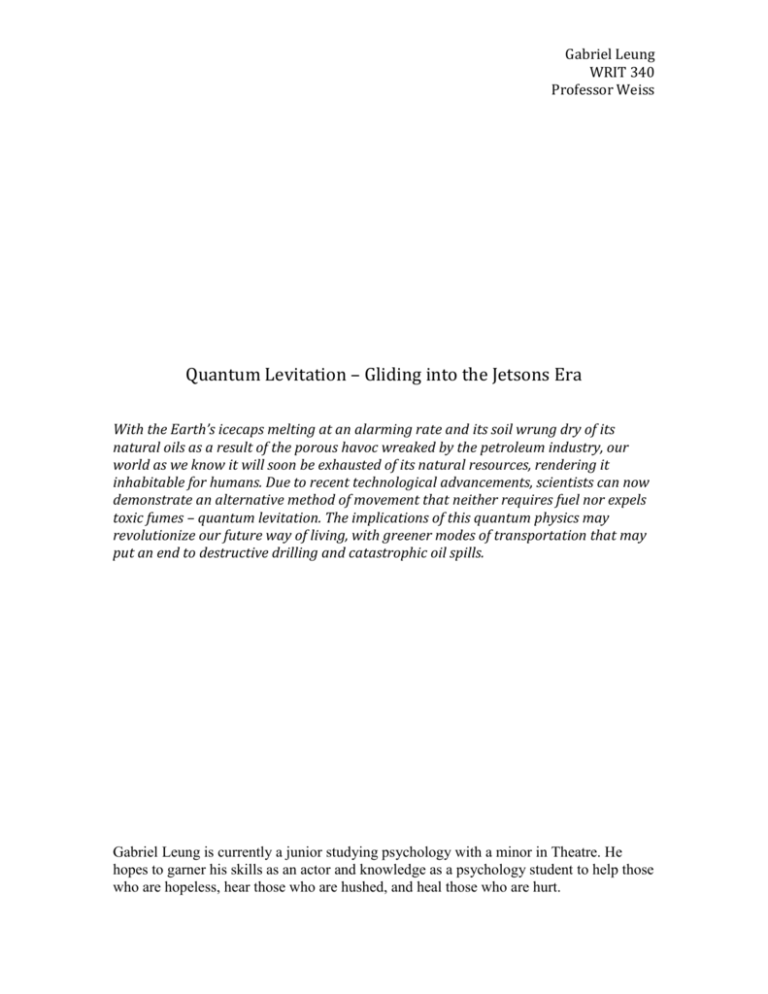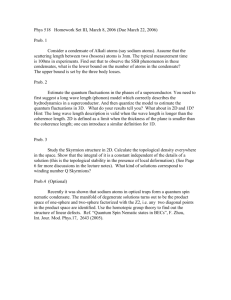Gabriel Leung WRIT 340 Professor Weiss Quantum Levitation
advertisement

Gabriel Leung WRIT 340 Professor Weiss Quantum Levitation – Gliding into the Jetsons Era With the Earth’s icecaps melting at an alarming rate and its soil wrung dry of its natural oils as a result of the porous havoc wreaked by the petroleum industry, our world as we know it will soon be exhausted of its natural resources, rendering it inhabitable for humans. Due to recent technological advancements, scientists can now demonstrate an alternative method of movement that neither requires fuel nor expels toxic fumes – quantum levitation. The implications of this quantum physics may revolutionize our future way of living, with greener modes of transportation that may put an end to destructive drilling and catastrophic oil spills. Gabriel Leung is currently a junior studying psychology with a minor in Theatre. He hopes to garner his skills as an actor and knowledge as a psychology student to help those who are hopeless, hear those who are hushed, and heal those who are hurt. Gabriel Leung WRIT 340 Professor Weiss Introduction “The Jetsons” is a cartoon series released in the 1960s depicting the lives of a family in the future. While its counterpart comic “The Flintstones” was dated in the Stone Age and was noted for its man-powered car with stone wheels, the Jetsons’ signature vehicle was a purple hovercraft that seemingly belonged solely in science fiction and imaginations [5]. However, recent demonstrations by quantum physicists suggest that this fictional future may be closer to our present than we ever dared envision. In a 2012 TedTalk presentation, scientist Boaz Almog not only levitated a thin ceramic disc above a magnet for a seemingly indefinite amount of time and rotated the hovering disc on its own axis and in different angles, he also demonstrated that quantum levitation also allows for the disc to float smoothly above a magnetic track as well as even upside down. While the term “quantum levitation” may sound like a modern science belonging to more recent or futuristic decades, it is a much older phenomenon discovered a hundred years ago. This gravity-defying science is based on specific materials referred to as ‘superconductors’, offering zero resistance to electrical currents and expelling magnetic fields when cooled below a precisely critical temperature [3]. Superconductivity and the Meissner Effect Discovered by Dutch physicist Heike Kamerlingh Onnes in 1911, superconductivity is characterized by the Meissner Effect, defined by magnetic field lines which are rejected and expelled by superconducting materials [6]. As superconductivity is a quantum state of matter that only occurs below a precise critical temperature, it may be wise to examine classical conductivity of everyday physics and how normal conductors react as they are cooled. As electrons flow about within the metallic conductors of daily life, they collide with other atoms and as a result lose certain amounts of energy in the form of heat these collisions of electrons result in electrical resistance. In classical physics, there is always some form of friction and energy loss. As temperatures are lowered, electrical resistance in normal metallic conductors decreases gradually [8]. In superconductors however, there is no collision of particles and thus zero energy dissipation. When superconductors are cooled to a certain critical temperature, their resistance drops abruptly to zero, offering electrical currents no obstacle or resistance and thus no energy loss, as it is a quantum effect [2]. This phenomenon is comparable to the difference between gradually turning the volume down on your computer speakers and pressing the mute button. Gabriel Leung WRIT 340 Professor Weiss The superconductor used in Boaz Almog’s TedTalk presentation is made of a ceramic material called yttrium barium copper oxide (YBa2Cu3O7-x ). At room temperature, this complex material shows no distinctive magnetic or electrical properties [11]. But once it is cooled to its critical temperature of -185˚C or 88 Kelvins, YBCO becomes a superconductor that conducts electricity with no resistance. Continuing with the previous analogy, this critical temperature of YBCO acts like a mute button, allowing for the sudden drop in electrical resistance. A second distinguishing characteristic of superconductors is the expulsion of magnetic fields from its interior, called The Meissner effect [8]. This is feasible because of their ability to circulate electrical currents without resistance. When superconductors are very thin however, as is the case for the YBCO disc that is only half a µm (nanometer) thick, discrete quantities of magnetic field strands do manage to penetrate the superconductor. These strands are called flux tubes or fluxons, and they penetrate in discrete quantities – this quantum phenomenon is thus called quantum locking [4]. This is analogous to the selective permeability of cellular membranes; where certain particles percolate through the membrane and are contained within the cell while others are rejected, repelled and have to circumvent. Gabriel Leung WRIT 340 Professor Weiss Quantum Locking and ‘Levitation’ Flux tubes behave like quantum particles, but are in fact strands of magnetic fields quantized within the superconductor. Any spatial movement of the superconducting disc will render the fluxons to move [6]. This is a movement undesirable for superconductors, as it may result in energy dissipation that would break the superconductivity state. As a result, the magnetic fluxons that managed to penetrate the disc are pinned at weak areas (i.e. grain boundaries) by the superconductor, in effect ‘locking’ them in place [7]. In doing so however, the superconductor also locks itself in space and in effect, ‘levitating’ midair. As mentioned above, fluxons rearrange themselves according to the movement of the superconductor, thus the disc can remain locked in space in whatever configuration and angle [1]. This means that the disc can be tilted and slanted in whatever orientation one maneuvers it to be in, much like UFOs in science fiction or the Jetsons’ hovercraft. This three dimensional locking of the superconductor has also been demonstrated on a circular magnetic track where the magnetic fields are the same all around, Gabriel Leung WRIT 340 Professor Weiss allowing the superconductor disc to move and rotate freely around the axis of the track. With the quantum locking maintained throughout, we now have frictionless movement of the superconducting disc [9]. Environmental Implications One may ask: Just how applicable is a half-micron thick superconducting disc to our daily lives, however impressive it's ability to ‘quantum levitate’ may seem to be? In knowing that superconductors can transfer and hold enormous amounts of current without resistance, scientists predict that superconductive materials can produce strong magnetic fields needed in MRI machines and particle accelerators. Its lack of energy dissipation could also produce power cables that could transfer unforeseen amounts of electrical currents between power stations, and even better, store a whole power-station’s worth of energy within a superconducting cable [8,10]. But the even bigger catch of this quantum phenomenon is that within the 3-inch diameter, half-micron thick disc, there are 100 billion strands of fluxons trapped within the superconductor, rendering the disc able to hold 70,000 times its own weight. If quantum physicists could extrapolate and advance this technology into a 2mm thick disc, the superconductor could hold up to 1000 kilograms – the weight of a small car [8]. Gabriel Leung WRIT 340 Professor Weiss Conclusions If the phenomenon of quantum levitation was discovered more than a hundred years ago, one might question why the technology has not been commercialized since? The fact of the matter is that modern technology had only hit its exponential growth boom since the 1990s, and our Earth had not faced such imminent environmental danger until recently. The quick rate with which personal technological devices keep upgrading every year may render the development of this greener mode of transportation to seem dishearteningly slow, but the ecological impact upon the release of frictionless hovercrafts may just propel our society up into a new era much like that of the Jetsons – a world with less friction, less entropy, less destruction. References [1] B. Almog, (2012, June). Boaz Almog: The levitating superconductor [Video File]. Available: http://www.ted.com/talks/boaz_almog_levitates_a_superconductor [2] A.S. Davydov and V. S. Loktev. High-Tc̳ Superconductivity: Experiment and Theory. Berlin: Springer-Verlag, 1992. [3] K. Fossheim and A. Sudbø. Superconductivity: Physics and Applications. Chichester, West Sussex, England: Wiley, 2004. [4] S. Gregoli, B. Raveau, and C. N. R. Rao. Superconductivity: New Insights and Current Trends in High-Tc Supeconductors. Luxembourg: Office for Official Publications of the European Communities, 1992. [5] "The Jetsons." IMDb. IMDb.com, n.d. Web. 13 Mar. 2014. [6] J.B.Ketterson and S. N. Song. Superconductivity. Cambridge: Cambridge UP, 1999. Print. [7] C.P. Poole, Superconductivity. Vol. Xxiii. Amsterdam: Elsevier/Academic, 2007. Print. [8] "Quantum Levitation." Quantum Levitation. N.p., n.d. Web. 11 Mar. 2014. <http://www.quantumlevitation.com/thephysics.html>. [9] S. Smith, R.Smith and A. Smith, Superconductors: Conquering Technology's New Frontier. New York: Plenum, 1988. Print. [10] A. Stwertka, Superconductors, the Irresistible Future. New York: F. Watts, 1991. Print. [11] "Yttrium Barium Copper Oxide - YBCO." YBCO. N.p., n.d. Web. 12 Mar. 2014. <http://www.ch.ic.ac.uk/rzepa/mim/century/html/ybco.htm>. Gabriel Leung WRIT 340 Professor Weiss





